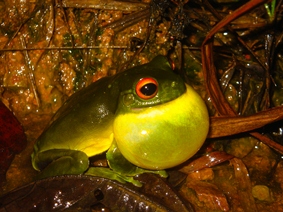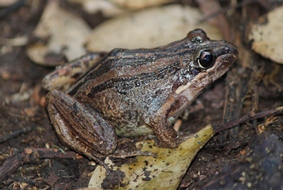About frogs

A backyard chorus of frog calls was once a common suburban sound; a sign that the frogs (and toads) would soon be breeding. Now, a frog calling in a backyard has become an oddity and an omen that something is wrong: the frogs are declining and have nowhere to breed. Across the suburbs the water that once filled seasonal streams and ponds now feeds into storm water drains. Many of the places where past generations of children went to collect tadpoles are now dry and the frogs are gone.
Adding a frog pond to your backyard is one way to help reverse this trend. Not only will a pond help restore frog habitat but will attract other native animals like dragonflies that have an aquatic stage in their life cycle, and provide a permanent water source for native birds, reptiles and mammals.
This page provides practical tips for what you need to consider if you want to attract frogs to your property.
What frogs live in your area?
The first thing to do is to find out what frogs are likely to live in your area so you can tailor your efforts to providing the habitat that best meets their needs. You can find this out quite easily by using the Wildlife online service on this website to make a list of the wildlife around your property or for your local government area.
If you have already seen or heard frogs in your local area you can identify them with the help of some of the species profiles on this website or invest in a wildlife guide that includes frogs and start your own backyard fauna survey.

Considering the needs of your local frogs
With a list in hand and some information (and your own observations) about the habitat preferences of local frogs you can start planning what you need to do to create frog habitat on your property. Treefrogs prefer dense, smooth-textured foliage and moist microclimates (common green treefrogs often live in downpipes and dainty green treefrogs will hide (and call) from the thick foliage on the lower branches of trees and tall shrubs). For frogs that live on the ground, the type of soil is important. A child’s sandpit full of moist river gravel is an ideal place for ornate burrowing frogs to dig in and striped marshfrogs will take up residence in an open compost heap.
Generally, ‘frog-scaping your garden’ will involve providing ground covers and low shrubs with dense foliage on the ground. Low trees or tall shrubs will provide shade and help buffer frog habitat from temperature extremes and moisture loss. The ground layer should be covered with leaf litter and have rocks and logs for frogs to hide under.
Frog habitat also needs to provide food and shelter for the insects and other invertebrates that frogs will feed on. It is important to remember that if you want to attract frogs you will also need to attract the insects they live on.
Just add water...
The final ingredient for a successful frog habitat is moisture. Frogs have a permeable skin and quickly dehydrate if they can’t maintain their moisture levels. A garden with areas that create a moist microclimate will naturally attract frogs.


